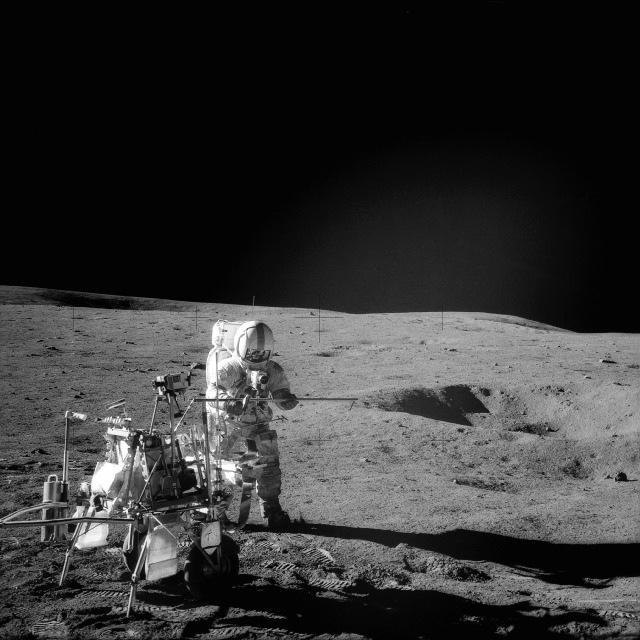
Forty-five years ago, this week, the sixth team of Apollo lunar explorers—and only the third to accomplish a landing on the Moon’s dusty surface—headed back to Earth after a mission which restored confidence in America’s space program after the near-disastrous Apollo 13. Astronauts Al Shepard, Stu Roosa, and Ed Mitchell (who died on Thursday) brought a scientific yield back home which illustrated that the Moon was a far more complex celestial body than previously believed. The mission of Apollo 14 itself was extraordinarily complex, but as well as being a technical story, it was also a very human story of one man’s battle against almost impossible odds to regain flight status.
The Apollo 14 crew did not share the same camaraderie as Pete Conrad’s Apollo 12 team, but a few episodes of note during their 19 months of training have been highlighted by Neal Thompson, in his biography of Shepard, Light This Candle. One geological training expedition took Shepard and Mitchell and their backups, Gene Cernan and Joe Engle, to a remote part of Bavaria, in the southeastern corner of Germany. Each evening, the men threw back huge tankards of beer and on one occasion they drunkenly climbed an old bell tower, just outside Munich, then had to pound on the doors of their dormitory which the proprietor had locked at 10 p.m. On another training expedition in southern Arizona, Cernan arranged to cross the border into Mexico to visit a friend’s restaurant for dinner. When they arrived, they were shown into a motel room and on a dresser stood four bottles of scotch and four room keys. Expecting dinner, the astronauts were shocked when four Mexican woman entered the room, each hopeful of sex with an astronaut that night.
“For the next 45 minutes,” wrote Neal Thompson, “in a mélange of tortured Spanish Spanish and charades, the spacemen tried to explain why they couldn’t stay. They each tried what little Spanish they knew: el presidente … no es possible … we can’t stay out late … we can’t drink … have to train for mission in the morning … going to Moon … la luna … During the ride back, the astronauts joked that they didn’t even get dinner.” Nor did any of them get chance to surreptitiously grab the bottles of scotch. …
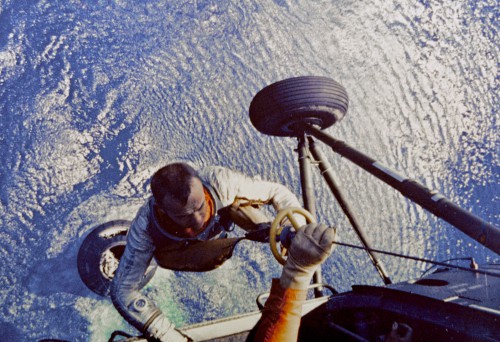
For Al Shepard, who had overcome an inner-ear condition known as Ménière’s Disease and whose career had seesawed from being America’s first man in space, to grounded and unable to even fly jets, to chief of the astronaut corps, to experimental medical procedure, to recovery and back onto flight status, the period from 1961 to 1971 had been a frustrating, though remarkable, decade. On Apollo 14, he would become the only member of the Original Seven Mercury astronauts to set foot on the Moon, and he trained feverishly for the opportunity. He flew the unforgiving Lunar Landing Training Vehicle (LLTV) more times than Gene Cernan could remember, taught himself to fly helicopters, and sweated every detail of the mission he was about to undertake. His crewmate Stu Roosa, the Command Module Pilot (CMP), would remain in lunar orbit, whilst Shepard and Lunar Module Pilot (LMP) Ed Mitchell descended to the Moon’s Fra Mauro foothills for two days of exploration.
Launch day, 31 January 1971, dawned cloudy and dreary at the Kennedy Space Center (KSC) in Florida. A persistent drizzle turned into a Sunday afternoon downpour, and the 3:23 p.m. EST launch was postponed by 40 minutes in the hope it would subside. The “window” for that day actually extended until 7:12 p.m., after which Apollo 14 would have to be postponed to 1 March. From within the command module, which they had named “Kitty Hawk” in honour of the location in North Carolina from where the Wright Brothers conducted the first sustained and controlled heavier-than-air flight in 1903. Shepard, Roosa, and Mitchell felt supremely confident that they could not suffer the massive electrical and other systems failures which had befallen Apollo 13. A third oxygen tank, isolated from the others, was included aboard their service module, together with a spare 400-amp battery, capable of supplying them with enough electrical power to handle all of their needs from any point in the mission.
All three men were keenly aware of President Richard Nixon’s stance on manned spaceflight; the axe on Apollos 18 and 19 had fallen barely four months earlier, and there were noises to cancel Apollos 16 and 17, too. Congress had slashed NASA’s budget to its lowest level in a decade, and for an apathetic public Apollo 14 encompassed far more than “just” going to the Moon: The crew had to restore a dimming sense of national pride and restore confidence in the program.
Before they could do that, however, they had to wait for the forces of nature to take their course. Thankfully, the storm lashed the launch pad only briefly and then headed out to sea, and the countdown resumed and proceeded without further incident. The access arm to the command module’s hatch was swung away, and the call of “Initiate firing command” signified the transition of the remainder of the countdown to the computers. With 50 seconds to go, the Saturn V rocket transferred its systems onto full internal power; and from the astronauts’ perspective, they could both hear and feel the behemoth coming to life, far below them. “He felt the first distant whispers of Saturn V flexing its sinews,” Shepard later wrote in third-person narrative of the experience in his and fellow astronaut Deke Slayton’s joint memoir, Moon Shot, “the rush of thousands of gallons of propellants hurtling downward through their lines, turbopumps spinning … He had the wild thought that the giant rocket was ten inches shorter than before fuelling. How could they get to the Moon with a booster that had shrunk? The fuel, of course. Millions of pounds of cold fuel contracting the rocket, bending metal … ”
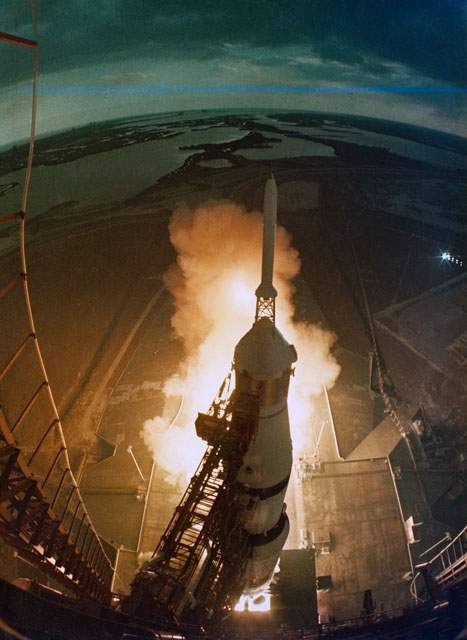
Nine seconds before launch, the Ignition Sequence Start command was given and kerosene and liquid oxygen poured into the combustion chambers of the Saturn’s five F-1 first-stage engines. Louise Shepard was bracing herself with her friend, Dorel Abbot, against a hurricane fence, 3 miles (5 km) from Pad 39A, and her recollection of those final seconds was of little more than a steadily increasing brightness of flame. The sound would not reach the assembled VIPs for 15 long seconds. “The Saturn V roared and screamed,” wrote Shepard, “anchored to its launch pad by huge, hold-down arms chaining it to Earth until computers judged the giant was howling with full energy.” That energy was unleashed at 4:03 p.m. EST, when countdown clocks in Mission Control touched zero and Apollo 14 headed firstly for Earth orbit and later the Moon.
As they left Earth, Shepard, Roosa, and Mitchell heard little more than distant, muted thunder, followed by a very gentle, almost jerky, motion as they gently rose from Pad 39A. The spectators saw something quite different: a terrifying, shrieking cataclysm of fire and thunder which sent flocks of birds fleeing in all directions and which pummeled chests and the soles of feet with intense shockwaves. Nor was the impact only felt at KSC. Nearly 1,250 miles (2,000 km) to the north, at Palisades Park, N.J., the roar of the Saturn shook atmospheric instruments at the Lamont-Doherty Geological Observatory.
The smooth ride gave way to a somewhat bumpier one when the first stage was jettisoned and the J-2 engines of the Saturn’s S-II second stage ignited. “Without constant acceleration and with the sudden cut-off of stage one,” wrote Shepard, “the three men jerked forward in their seats. The accordion stretched out and then compressed again; the fuels sloshed and the astronauts felt a series of bumps, just like a train wreck.” Next came the jettisoning of the escape tower, which uncovered the command module’s windows, but through which they could see virtually nothing, save the profound blackness of space. Thirteen minutes after leaving Florida, and with the S-II and the first burn of the restartable S-IVB third stage finally behind them, Shepard, Roosa, and Mitchell were in orbit.
“That alone,” exulted Shepard, “was almost worth the entire trip!”
The second part of this article will appear tomorrow.
Be sure to “Like” AmericaSpace on Facebook and follow us on Twitter: @AmericaSpace




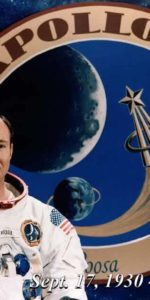
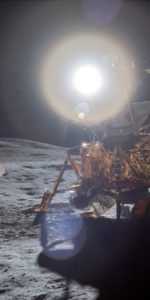
As the years pass by, the photos from the lunar surface of the Apollo missions become more incredible and spectacular. How fortunate for humanity to have had that experience!